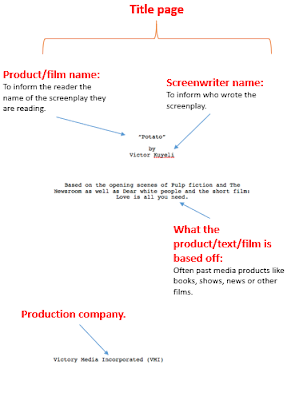The first page always has to be able to make the reader of the script know: who wrote the script, the production company, the name of the film and what the text is based off of/inspired by. This helps with identifying the script. A sulgline/scene heading is used to set the scene and help the prop team, editors and everyone else involved in making the film aware of what the scenes will need to look like.
It was incredibly hard to write my script in a way that my characters would be convincing, especially when there's very little action in the film between the characters and they spend the majority of the time sat at a bar table arguing. The hardest part of was making the characters believable with their opinions and dialogue, so to combat this I went around and asked various people their thoughts on the topics that were going to come up in the film just so that I could get more that one opinion - my own. Once I asked all the people and collected a good amount of varied responses, I started writing the script only to realize that all the content I wanted to put in the film wouldn't fit within the 10 minute time period that the film was meant to be within. After trimming the content to just 2 topics - racism and homophobia - I also had to strip the development of the discussions so they would still be interesting when translated onto screen.
Usually when writing a script, a page of screenwriting is equivalent to about a minute of film, however with a dialogue heavy film like mine, it's not the case because my script was 14 pages long but after filming and editing is likely to be a lot shorter than the 14 minutes it'd usually be.
I tried to make sure that both protagonists fit their character descriptions through their use of dialogue with each having strong opinions on their believes and making them seem intelligent but realistic so they don't start using sophisticated words mid-sentence. I think this is vital for the characters to be believable and relatable to some of my target audience, hopefully all this can be translated into the film.
The film will only have three characters in it (Sam, Laura and the waiter), so to add a different aspect of the film I added Sam's voice as a voice over (shown as SAM (VO) in the screenplay) to fill the quiet moments with some dialogue, tell the audience what Sam is thinking and more especially is used to give reason for Sam's actions otherwise the film would be a lot harder to understand.
The script is written in a linear storyline with the conflict starting very early into the film and unlike normal dramas isn't caused by an action but is instead triggered by the dialogue of one character. The script has minimal twists or plot points because I wanted to focus more on what the characters were saying and trying to make the viewer question themselves rather than focusing on the actions that happens.
Parenthesis are extremely important in certain situations and scenes because they let the director know how each character should be acting and performing in a scene, this is even more important if that action they are doing can/does affect future events.
I used the same "Cut to" transition feature throughout the script because I felt it was the best choice when comparing it to other transition types because it shows that something else is happening straight after the scene that the viewer has just seen. The other option that I could've used was the "Dissolve to" feature which would be very effective at the beginning of my film after Laura leaves Sam on the bus/bench because it would symbolise a passing of time and I wouldn't have to explain it to the audience as a subtitle or as a voiceover.
There's no shot types on my script because I didn't want to restrict myself to certain angels and shot types when filming, plus I hadn't done the storyboard at that point and I was still writing so I didn't want to end up using the same shot types over and over again, so choosing angles would be hard to do.



No comments:
Post a Comment